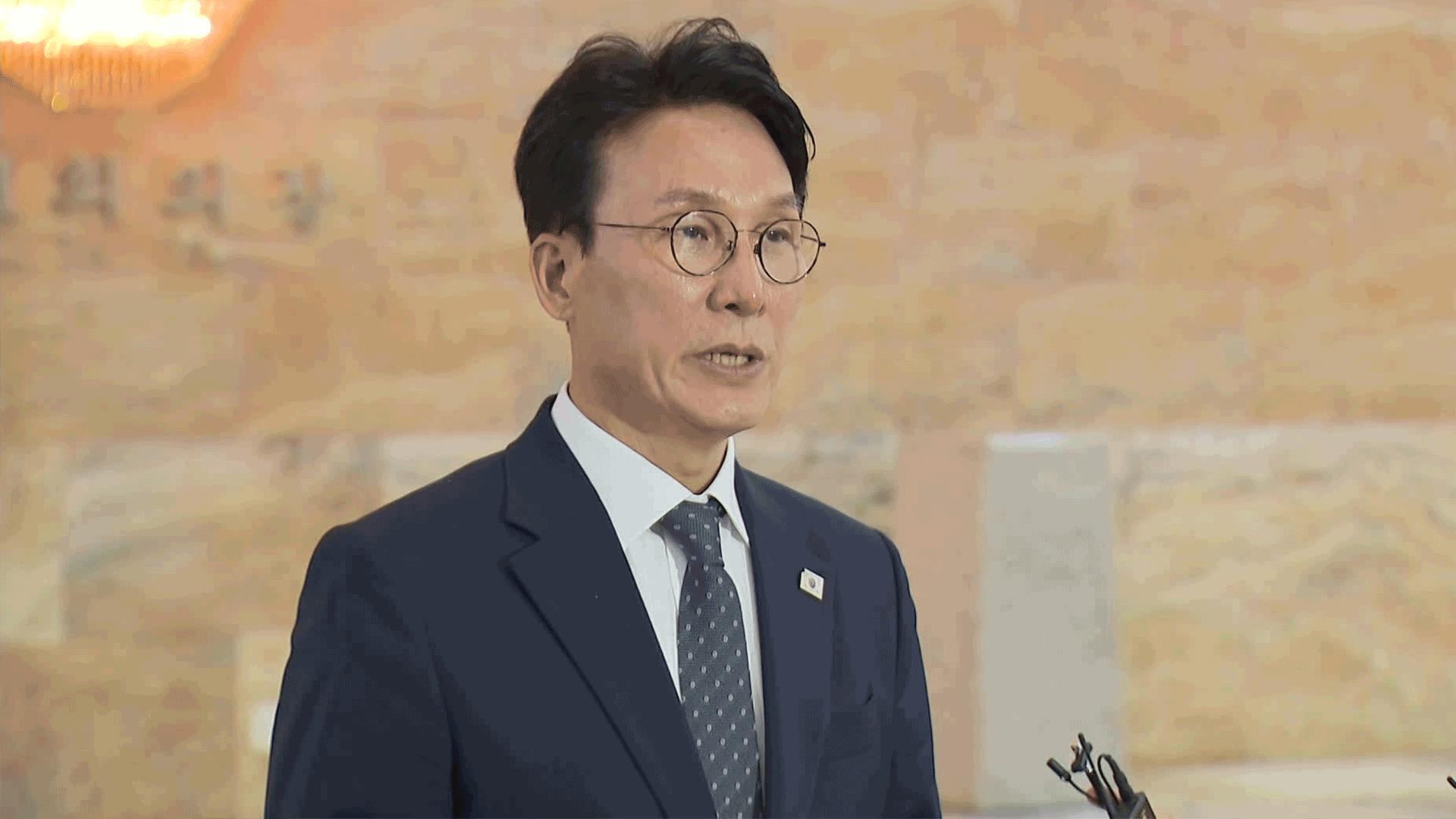Rise in sea temperatures even at deeper water depths shake aquaculture as fishermen search for alternative fish species
입력 2024.11.18 (02:33)
수정 2024.11.18 (10:22)
읽어주기 기능은 크롬기반의
브라우저에서만 사용하실 수 있습니다.
[Anchor]
Recent reports indicate a significant increase in seafood prices, attributed to the prolonged heat affecting our oceans this past summer. The uncooled seas have caused extensive damage to aquaculture farms, making it a crucial task for our fishermen to find alternative fish species that can withstand high temperatures.
This report was conducted by journalist Lee Gyu-myeong.
[Report]
The tidal flats of Seosan, Chungnam.
It is the clam harvesting season, but only dead clam shells are scattered around.
[Jang Seon-soon/Head of Oji-ri Fishing Village in Seosan, Chungnam: "It would not be an exaggeration to say that the tidal flats are all rotten, and when the sea temperature is high, these creatures die."]
The area of clam farms affected by rising sea temperatures reaches the size of 3,200 soccer fields in five nearby cities and counties.
The cage farming site in Tongyeong, Gyeongnam.
Seventy percent of the rockfish raised over two years have died.
This is because, for more than two months, the water temperature has exceeded 28 degrees even at the deeper depths where the water is normally cooler.
[Kim Su-hwan/Cage farming fisherman: "This year, unusually, the surface and deep water temperatures were the same. No matter how deep we set the nets, it was 31 degrees at the bottom and 31 degrees at the top, so it seems that's why all the fish died."]
Off the coast of Samcheok, Gangwon-do, we went down over 20 meters.
We can see species like the bluefin snapper and the golden threadfin bream, which were only seen in Jeju waters.
All of these species were previously not found in the East Sea.
[Kim Byeong-jik/Researcher at the National Institute of Biological Resources, Ministry of Environment: "Subtropical fish species have started to appear. Notably, we've sighted juvenile and adult fish of the subtropical black seabream."]
The number of places researching the farming of subtropical species is also increasing in line with the rising sea temperatures.
The Gyeongsangnam-do Fisheries Resources Research Institute, along with the local fishermen, is cultivating subtropical species like the threeline grunt .
[Kim Su-hwan/Cage farming fisherman: "As the water temperature rises, we need to adapt. We need to change and find fish that suit us."]
[Kim Gi-tae/National Fisheries Research Institute, Southeastern Sea Research Institute: "It seems that the most urgent task is to find subtropical species that are resilient to temperature changes and to discover alternative varieties suitable for the domestic environment."]
The urgent task of farming and distributing alternative fish species fitting to the rapidly changing marine environment is emerging as a critical issue.
This is KBS News, Lee Gyu-myeong.
Recent reports indicate a significant increase in seafood prices, attributed to the prolonged heat affecting our oceans this past summer. The uncooled seas have caused extensive damage to aquaculture farms, making it a crucial task for our fishermen to find alternative fish species that can withstand high temperatures.
This report was conducted by journalist Lee Gyu-myeong.
[Report]
The tidal flats of Seosan, Chungnam.
It is the clam harvesting season, but only dead clam shells are scattered around.
[Jang Seon-soon/Head of Oji-ri Fishing Village in Seosan, Chungnam: "It would not be an exaggeration to say that the tidal flats are all rotten, and when the sea temperature is high, these creatures die."]
The area of clam farms affected by rising sea temperatures reaches the size of 3,200 soccer fields in five nearby cities and counties.
The cage farming site in Tongyeong, Gyeongnam.
Seventy percent of the rockfish raised over two years have died.
This is because, for more than two months, the water temperature has exceeded 28 degrees even at the deeper depths where the water is normally cooler.
[Kim Su-hwan/Cage farming fisherman: "This year, unusually, the surface and deep water temperatures were the same. No matter how deep we set the nets, it was 31 degrees at the bottom and 31 degrees at the top, so it seems that's why all the fish died."]
Off the coast of Samcheok, Gangwon-do, we went down over 20 meters.
We can see species like the bluefin snapper and the golden threadfin bream, which were only seen in Jeju waters.
All of these species were previously not found in the East Sea.
[Kim Byeong-jik/Researcher at the National Institute of Biological Resources, Ministry of Environment: "Subtropical fish species have started to appear. Notably, we've sighted juvenile and adult fish of the subtropical black seabream."]
The number of places researching the farming of subtropical species is also increasing in line with the rising sea temperatures.
The Gyeongsangnam-do Fisheries Resources Research Institute, along with the local fishermen, is cultivating subtropical species like the threeline grunt .
[Kim Su-hwan/Cage farming fisherman: "As the water temperature rises, we need to adapt. We need to change and find fish that suit us."]
[Kim Gi-tae/National Fisheries Research Institute, Southeastern Sea Research Institute: "It seems that the most urgent task is to find subtropical species that are resilient to temperature changes and to discover alternative varieties suitable for the domestic environment."]
The urgent task of farming and distributing alternative fish species fitting to the rapidly changing marine environment is emerging as a critical issue.
This is KBS News, Lee Gyu-myeong.
■ 제보하기
▷ 카카오톡 : 'KBS제보' 검색, 채널 추가
▷ 전화 : 02-781-1234, 4444
▷ 이메일 : kbs1234@kbs.co.kr
▷ 유튜브, 네이버, 카카오에서도 KBS뉴스를 구독해주세요!
- Rise in sea temperatures even at deeper water depths shake aquaculture as fishermen search for alternative fish species
-
- 입력 2024-11-18 02:33:54
- 수정2024-11-18 10:22:53

[Anchor]
Recent reports indicate a significant increase in seafood prices, attributed to the prolonged heat affecting our oceans this past summer. The uncooled seas have caused extensive damage to aquaculture farms, making it a crucial task for our fishermen to find alternative fish species that can withstand high temperatures.
This report was conducted by journalist Lee Gyu-myeong.
[Report]
The tidal flats of Seosan, Chungnam.
It is the clam harvesting season, but only dead clam shells are scattered around.
[Jang Seon-soon/Head of Oji-ri Fishing Village in Seosan, Chungnam: "It would not be an exaggeration to say that the tidal flats are all rotten, and when the sea temperature is high, these creatures die."]
The area of clam farms affected by rising sea temperatures reaches the size of 3,200 soccer fields in five nearby cities and counties.
The cage farming site in Tongyeong, Gyeongnam.
Seventy percent of the rockfish raised over two years have died.
This is because, for more than two months, the water temperature has exceeded 28 degrees even at the deeper depths where the water is normally cooler.
[Kim Su-hwan/Cage farming fisherman: "This year, unusually, the surface and deep water temperatures were the same. No matter how deep we set the nets, it was 31 degrees at the bottom and 31 degrees at the top, so it seems that's why all the fish died."]
Off the coast of Samcheok, Gangwon-do, we went down over 20 meters.
We can see species like the bluefin snapper and the golden threadfin bream, which were only seen in Jeju waters.
All of these species were previously not found in the East Sea.
[Kim Byeong-jik/Researcher at the National Institute of Biological Resources, Ministry of Environment: "Subtropical fish species have started to appear. Notably, we've sighted juvenile and adult fish of the subtropical black seabream."]
The number of places researching the farming of subtropical species is also increasing in line with the rising sea temperatures.
The Gyeongsangnam-do Fisheries Resources Research Institute, along with the local fishermen, is cultivating subtropical species like the threeline grunt .
[Kim Su-hwan/Cage farming fisherman: "As the water temperature rises, we need to adapt. We need to change and find fish that suit us."]
[Kim Gi-tae/National Fisheries Research Institute, Southeastern Sea Research Institute: "It seems that the most urgent task is to find subtropical species that are resilient to temperature changes and to discover alternative varieties suitable for the domestic environment."]
The urgent task of farming and distributing alternative fish species fitting to the rapidly changing marine environment is emerging as a critical issue.
This is KBS News, Lee Gyu-myeong.
Recent reports indicate a significant increase in seafood prices, attributed to the prolonged heat affecting our oceans this past summer. The uncooled seas have caused extensive damage to aquaculture farms, making it a crucial task for our fishermen to find alternative fish species that can withstand high temperatures.
This report was conducted by journalist Lee Gyu-myeong.
[Report]
The tidal flats of Seosan, Chungnam.
It is the clam harvesting season, but only dead clam shells are scattered around.
[Jang Seon-soon/Head of Oji-ri Fishing Village in Seosan, Chungnam: "It would not be an exaggeration to say that the tidal flats are all rotten, and when the sea temperature is high, these creatures die."]
The area of clam farms affected by rising sea temperatures reaches the size of 3,200 soccer fields in five nearby cities and counties.
The cage farming site in Tongyeong, Gyeongnam.
Seventy percent of the rockfish raised over two years have died.
This is because, for more than two months, the water temperature has exceeded 28 degrees even at the deeper depths where the water is normally cooler.
[Kim Su-hwan/Cage farming fisherman: "This year, unusually, the surface and deep water temperatures were the same. No matter how deep we set the nets, it was 31 degrees at the bottom and 31 degrees at the top, so it seems that's why all the fish died."]
Off the coast of Samcheok, Gangwon-do, we went down over 20 meters.
We can see species like the bluefin snapper and the golden threadfin bream, which were only seen in Jeju waters.
All of these species were previously not found in the East Sea.
[Kim Byeong-jik/Researcher at the National Institute of Biological Resources, Ministry of Environment: "Subtropical fish species have started to appear. Notably, we've sighted juvenile and adult fish of the subtropical black seabream."]
The number of places researching the farming of subtropical species is also increasing in line with the rising sea temperatures.
The Gyeongsangnam-do Fisheries Resources Research Institute, along with the local fishermen, is cultivating subtropical species like the threeline grunt .
[Kim Su-hwan/Cage farming fisherman: "As the water temperature rises, we need to adapt. We need to change and find fish that suit us."]
[Kim Gi-tae/National Fisheries Research Institute, Southeastern Sea Research Institute: "It seems that the most urgent task is to find subtropical species that are resilient to temperature changes and to discover alternative varieties suitable for the domestic environment."]
The urgent task of farming and distributing alternative fish species fitting to the rapidly changing marine environment is emerging as a critical issue.
This is KBS News, Lee Gyu-myeong.
이 기사가 좋으셨다면
-
좋아요
0
-
응원해요
0
-
후속 원해요
0












![[단독] 도이치 주포 “김건희, 내 덕에 떼돈 벌어…22억 원 주문”](/data/news/2025/07/03/20250703_KpuU43.png)
![[단독] “쪽지 얼핏 봤다, 안 받았다”더니…CCTV에선 문건 챙긴 이상민](/data/news/2025/07/03/20250703_Lv3LjI.png)


이 기사에 대한 의견을 남겨주세요.